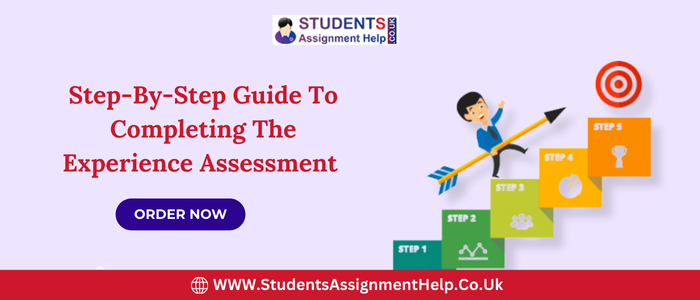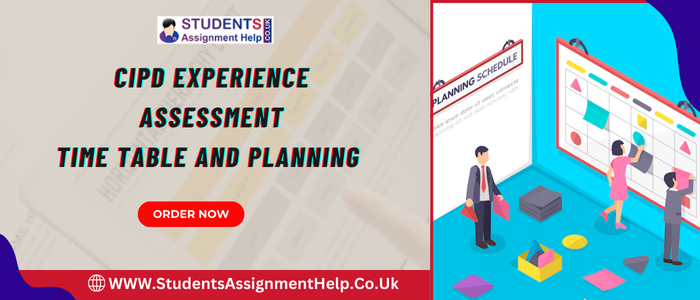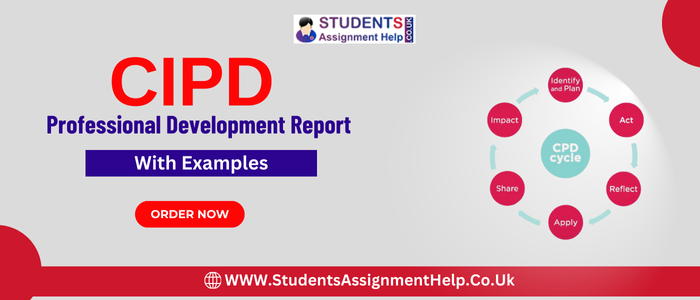What is CIPD Experience Assessment?
With the fast-growing dynamics of the current business environment, both HR and L&D specialists are required to prove their competency and be up-to-date with the requirements of the industry.
The CIPD Experience Assessment (as it is officially known) provides an opportunity for human resources employees with post-qualification work experience to gain a CIPD membership without pursuing formal education certificates. The below guide seeks to explain what the CIPD Experience Assessment is all about and how it can be of advantage to anyone in people management.

Why Choose the Experience Assessment Route while pursuing CIPD?
The Experience Assessment route is seen as a modern development in the granting of professional recognition with reference to those workers for whom practice learning has been their primary way of acquiring academic knowledge. This pathway is suitable for working HR and L&D employees who have been practising their skills for years but have no appropriate academic background to support excessive work experience.
This route is particularly valuable for professionals who:
- Have a great deal of practical experience in other HR or L&D positions where they can better exemplify the application of professional comprehension and proficiency. While some of these professionals may have no prior work experience, most of these individuals usually have several years of experience in project management, change management, or planning and executing human capital strategic initiatives.
- Want to affix CIPD since they understand that although their practical experience is useful, they would prefer to have a nationally recognised professional certificate. What many working in human resources and related positions say is that though their years of service can travel very far, having a CIPD membership can take one even further and offer additional opportunities.
- These are individuals who cannot engage in mainstream academic processes due to factors like time, work and other responsibilities among others. The Experience Assessment provides another more relaxed model that respects their prior learning profile and acknowledges their present obligations at the workplace.
Get Special Discount Offers for Assignment Help
How the Membership Standards are Assessed in this Pathway?
Specialist and Generalists
The CIPD Experience Assessment is developed taking into consideration the fact that HR & L & D professionals hail from an array of backgrounds and many specialised fields. It also means that no matter what your area of focus is, the staff of your organisation, thanks to this assessment, can show that they are competent in their field.
For specialists who have focused their careers in areas such as:
- Employee relations
- Learning and development
- Talent acquisition
- Compensation and benefits
- organisational development
It enables them always to go deeper into the field they specialise in while at the same time keeping a bird’s eye view of the human resource management principles. This balance provides a way that the specialists do not get limited by their specialism but rather have a way they establish that they are assets in the organisation.
The CIPD Profession MAP
The core of this process is the CIPD Profession Map, which is a detailed guide outlining what the people profession considers to be best practice. This map gives the assessment process the basic structure and thus offers an excellent framework of what professionalism in HR and L&D entails.
The assessment evaluates candidates’ proficiency in several key areas:
- Strategic people management
- Change implementation
- organisational development
- Professional ethical and professional behaviors
- Data-driven decision making
- Stakeholder management
Applicants need to explain how they met these standards, and include specific experience references in order to show how comparable concepts were used in practice.
Hire an Essay Writer to Write your Complete Essay on Time
info@studentsassignmenthelp.co.uk
Steps in the CIPD Experience Assessment Process
Step 1: Familiarise Yourself with the Guidance
It starts with the learning of all the possible and expected demands of that specific assessment. This crucial first step sets the foundation for a successful assessment experience:
The common areas to understand are the membership standards, which can be explained by identifying and analysing the CIPD’s materials and the list of the requirements connected with the membership level chosen. You need to read and be conversant with the core behaviours, knowledge areas, and the expected impact against the membership grade that is appealing to you.
The experience assessment portal is equipped with multiple instrumentations such as videos, samples and tutorials from which clients can gain detailed information. Using this kind of materials, and spending time to go over them properly will make a lot of difference in the preparation process and in enhancing confidence.
The CIPD EA support team is also present to help any candidates who may need some modifications OR is there to offer help to the candidates. Do not hesitate to contact me if you have any questions or concerns regarding any of the assessment activities.
Step 2: Plan Your Time
Effective time use is another very important factor to tap into once practising the Experience Assessment. The eight-week timeframe requires careful planning and dedication:
The recommended time allocation includes:
- About 5 total days for writing exams
- Extra time to collect supporting data
- Perios for gathering and integrating the views of the people that may be affected by the result
- Intervals within which revisions of your submissions have to be done and implemented.
A preplanned hybrid schedule is useful as it allows for covering all programs and tasks helping to manage professional commitments as well.
Pay to get your assignments done on time
Step 3: Schedule for Your Professional Discussion
The professional discussion is a key component of the assessment process:
Once they admit you to the portal, CIPD will then contact you within 10 working days to organise your professional discussion. Such early scheduling enables you to organise how you will be preparing for this crucial discussion in advance.
The discussion is done through a Video link (Skype or Zoom) to ensure that it can be done anywhere that the candidate prefers. This format provides the comfort of professionalism that enables you to disclose all you know to the employer.
Step 4: Start and Submit Your Assessments
The written assessments form the core of your application, requiring careful thought and detailed examples:
Knowledge and Impact Report: This document is an opportunity to demonstrate that you know and understand the principles that are inherent to the field of HR/L&D and how they can be implemented in practice. The emphasis is made on cases where your expertise helped generate tangible results for your organisation. Don’t forget such characteristics as metrics, outcomes, and what can be learnt from such experiences.
Behaviour Report: Prove that you meet CIPD behaviour standards in specific ways. This involves explaining how professional behaviours were demonstrated in contentious circumstances and how these behaviours impacted the right results.
Professional Development Report: Consider and discuss the learning process and key emerging trends as well as the specific areas of development that may be interesting to the learner in the future. Also, ensure feedback from stakeholders to boost the argument with solid proof of the program’s effectiveness for personal development.
Step 5: Professional Discussion
The professional discussion represents a crucial opportunity to elaborate on your written submissions:
This 2-3 hour structured conversation with an assessor allows you to:
- Provide more samples from your writings
- Elaborate your encounters where possible to create more subscribers.
- Highlight your professionalism and how you arrived at your decision-making.
- Explain current trends and issues in HR/L&D
- Explain your further evolution strategies
This aspect of the discussion should be done with some preparation of the inputs that you make and other examples that can support the discussion.
Step 6: Receive Results and Feedback
The final stage of the process provides valuable insights into your professional standing. Approximately six weeks after your professional discussion, you’ll receive comprehensive feedback including:
- The outcome of the assessment
- A detailed analysis of what has been identified as your competencies
- Areas for further development
- Recommendations with a context to the ongoing professional development
- Guidance on what you should do next in your profession
Still thinking, See our best assignment deals Now!
Examples of Impact by Different Membership Levels of CIPD
Associate Member
Associates typically demonstrate operational impact through:
- Coordination of the day-to-day operation of the company about HR policies and procedures
- Successful organisation change management is therefore ensuring that the organisation change initiatives are properly supported and fully aligned with the wider organisation and its employees.
- Delivering training programs
- Overseeing the administration of employing people
- Managing employee relation cases
Chartered Member
Chartered Members show strategic impact through:
- Strategies for Human Resource Management together with business goals
- Most programs of change management in organisations
- Developing and Executing Talent Management Systems
- Designing creative L&D PCS
- Dealing with numerous sophisticated aspects of employee relations
Chartered Fellow
Fellows demonstrate leadership impact through:
- The organisational culture and strategy are again being shaped by the competencies.
- Leading change
- Determining decisions that must be made at that level
- Becoming a member of the larger family of the human resource profession
- The emphasis on university students and the development of future heads of HR departments
Consult with British Essay Writers to Write your College Essay
info@studentsassignmenthelp.co.uk
Benefits of pursuing CIPD Experience Assessment
The Experience Assessment pathway offers numerous advantages for HR and L&D professionals:
- Getting acknowledged all over the world through a reputed membership also adds to your qualifications to a great extent. CIPD membership is now accepted globally as a benchmark standard for people’s professions.
- You get a chance to access resources, networks, and professional development facilitating your continued learning of new trends in practice. In addition, the CIPD offers tools to develop further a wealth of knowledge and a network that can be utilised continuously.
- Better career opportunities and credibility of both HR and L&D professions contribute to further developments for professionals on the career ladder. There are currently many vacancies where organisations want only CIPD-qualified candidates for managerial and other positions.
Tips for Success in CIPD Experience Assessment
To maximise your chances of success in the Experience Assessment:
- Be specific and briefly write assessments that evidence your stimulating contributions that have a differential impact within the recent past. Concentrate on contexts in which you have affected change or a return on profit or loss within your business or for those benefiting from your work.
- Relate well and act towards strict deadlines, making a schedule that will suit your time without compromising the rest of your activities. Subsequently, internal deadlines should be established earlier than the actual submission dates.
- Get people involved well in advance so that you get staggered feedback and where explain to people clearly what you need from them. It helps to know that you do make a difference and their input can be a very useful form of validation.
- Endeavour to be as prepared as possible for the professional discussion, especially on the impact and have your examples backed up with numbers. You should also make an effort how to communicate your experience and achievements economically.
Get Special Discount Offers for Assignment Help
Conclusion
The CIPD Experience Assessment stands as a great chance for experienced HR and L&D professionals to obtain professional certification relying on practical experience instead of pursuing academic degrees. CIPD members are expected to meet certain standards; this rigorous assessment process affirms your practical experience.
Preparing both for stages of the assessment, collecting solid proof of your contributions, and showing how you adhere to the CIPD Exam syllabi, will help you pass through the pathway and become a CIPD member. The benefits accompanied by the CIPD membership can boost your position and opportunities to develop in the people profession.
Moreover, let it be emphasised that this process is not just about becoming a member – it is about professional learning too. The process on its own can serve as the developmental experience, which allows the submission for the planning of further career paths in the area of HR and L&D.
Hire CIPD Specialists To Pass Your Experience Assessment in One Go
You can get access to hundreds of native experts once you decide to hire us for your CIPD assignment help in UK. Experienced tutors with Students Assignment Help UK assure you that you will be passed in experience assessments. You will be provided with unique answers without any hint of AI and plagiarism.
Online assignment writers can help you prepare for your professional discussions which will increase your chances of crossing the final line of your career dreams. So what are you waiting for fill out the simple form on our website today and start with excellence in CIPD assignment writing.























